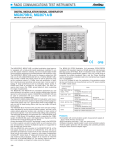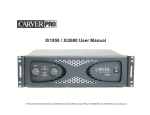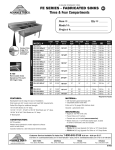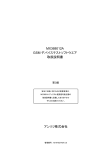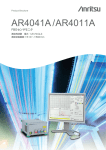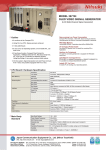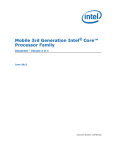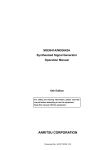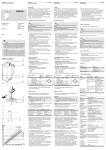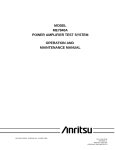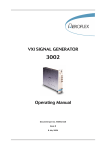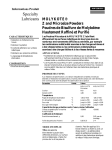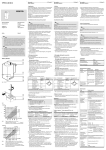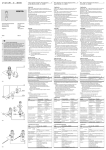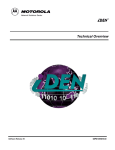Download MG3670B/C, MG3671A/B, MG3672A
Transcript
® E stablished 1981 Advanced Test Equipment Rentals www.atecorp.com 800-404-ATEC (2832) RADIO COMMUNICATIONS, EMI MEASURING TEST INSTRUMENTS DIGITAL MODULATION SIGNAL GENERATOR MG3670B/C, MG3671A/B, MG3672A 300 kHz to 2.25/2.75 GHz For Measuring Signals of Digital Mobile Communication Systems in North America, Europe and Japan GPIB The MG3670B/C, MG3671A/B and MG3672A are digital modulation signal generators equipped with a high-performance quadrature modulator. They output the signals needed to develop, test, and evaluate digital mobile communications equipment and related devices with expansion units. The MG3670B/C operates from 300 kHz to 2.25 MHz; the MG3671A/B and MG3672A operate 300 to 2.75 MHz. Both provide a stable and precise output as well as spectrum purity up to +13 dBm, even with modulation. In addition to testing receiver sensitivity and excess input, they can be used for testing IF stage performance and for evaluating device quality. A CMOS-level mode is provided for I/Q signal input. The input frequency band covers the CDMA spread spectrum band, expanding the range of applications. The MG3670C/3671B/3672A can be expanded by rear panel extension connectors to use for auxiliary signal output functions special to communication system. MG3670B/C, MG3671A/B and MG3672A can be used in combination with up to eight modulation units and a burst function unit simultaneously. The MG0301C/0302A/0305A/0307A/0311A modulation units have a continuous data generator capable of generating arbitrarily-programmable data signals and ITU-T specification PN9/15 stage PRBS signals. They also have band-limiting filters and can output I/Q baseband signals. The MG0303A Burst Function Unit uses the frame and slot configuration stipulated by various communication systems and has a modulation pattern generator function and a function for ramp control of carrier burst signals. It can also handle data editing and scrambling. The MG0310A Modulation Unit generates SS + QPSK/OQPSK modulated (1.2288 Mcps) I/Q baseband signals, supporting the CDMA system (TIA/EIA/IS-95) used in US Digital Cellular Systems and the US Personal Communications Service (PCS). Anritsu-developed DSP and ASIC technology is used in the MG0310A to achieve superior waveform quality factor (ρ) and spurious emission characteristics. Channel multiplexed signals are supported for both forward and reverse links. With two MG0310A units mounted in the MG3670C/3671B/3672A, all the test signals required to conform to TIA/EIA/IS-95, -97, and -98 can be generated. Simultaneous outputs from the rear extension connectors using long and short codes, etc., support a wide range of applications including RF related tests, IF stage performance tests, and device and module quality evaluation. (Option 25 is required to install the MG0310A in the MG3670B/3671A. The auxiliary signal output function is not installed, so long/short codes cannot be output.) 290 The MG0312A QPSK Modulation Unit generates QPSK/OQPSK modulated I/Q baseband signals at 8 high-speed bit rates between 500 kbps and 2.4576 Mbps. Built-in modulation data includes PN7/ PN9/PN15/PN23 pseudorandom patterns. Use over a wide range is supported by multiple baseband filters and the Phase Encoding function, which allows modulation data to be voluntarily phase mapped onto a constellation. At the 2.4576 Mbps rate, the evaluation of transmission section devices and modules can be performed such as RF power amplifier for CDMA mobile stations. The MG0314A Modulation Unit generates DS + QPSK modulated (4.096/1.024 Mcps) I/Q baseband signals, supporting the W-CDMA system specification. The various test signals required for W-CDMA system experimentation can be generated by mounting the MG0314A unit (it shares two slots) in the MG3672A. Communication systems Units PHS, PDC, PDC_H, NADC, TFTS MG0301C π/4 DQPSK Modulation Unit GSM, PCN (DCS1800), CT2 MG0302A GMSK Modulation Unit DECT MG0305A GFSK Modulation Unit PACS, WCPE, PHS MG0307A π/4 DQPSK Modulation Unit TETRA MG0311A π/4 DQPSK Modulation Unit IS-95 W-CDMA*1 MG0303B Burst Function Unit MG0310A CDMA Modulation Unit MG0312A QPSK Modulation Unit MG0314A W-CDMA Modulation Unit (only MG3672A) *1: Corresponds to the specification for W-CDMA system experimentation Features • Compatible with communication system measurement signals of Japan, North America and Europe • High modulation accuracy (≤1.8% rms vector error) • Outputs modulation signals suited to each communication system • Internal pattern generator with data-editing and scrambling functions • Outputs IS-95 channel multiplex signal • Outputs W-CDMA channel multiplexes signal (only for MG3672A) • Wide range (30 MHz, 3 dB) I/Q Input (only for MG3672A) www.anritsu.com For product ordering information, see pages 4-7. RADIO COMMUNICATIONS, EMI MEASURING TEST INSTRUMENTS Basic performance • I/Q input supporting wide range of applications (only for MG3672A) The MG3672A is equipped with wide-band I/Q input from DC to 30 MHz (3 dB) so that wide-band quadrature modulation can be performed. This ensures that the MG3672A will remain fully compatible with communication systems for which band expansion is planned in the future. SSB phase noise at 1.9 GHz • Large output level Through use of new AGC circuitry, the MG3670B/C, MG3671A/B, and MG3672A produce a highly precise output at levels down to –143 dBm with stable frequency characteristics, not only for output of unmodulated signals but also with π/4 DQPSK modulation accompanied by amplitude fluctuations and when outputting burst signals. The MG3670B/C, MG3671A/B and MG3672A can generate a high output level of up to +13 dBm over a broad range of frequencies, so amplifiers are not needed even when testing receivers for excess input and in testing other devices. 6 Frequency response for I/Q external modulation (typical values) • I/Q signal I/O over broad frequency range (only for MG3670B/C, MG3671A/B) A quadrature modulator is built in, and external I/Q signals can be input to enable use with a variety of digital modulation modes, including QPSK, 8PSK, and M16QAM. The modulation band for I/Q input signals is broad, covering the CDMA spread spectrum bandwidth. Further, by adding an expansion unit, I/Q signal output can be obtained from the internal data generator. Either 50 Ω or CMOS-level compatibility can be selected for I/Q signals. Functions for adjusting the level balance, offset, and phase are also provided for greater utility in evaluating modulators/demodulators and other devices. Level (dB) 0 Output level frequency characteristics –1 –2 –3 (50 Ω/0.5 Vrms mode) 30 k 100 k 300 k 1M 3M I/Q signal input frequency (Hz) 10 M Frequency response for I/Q external modulation (typical values) • Excellent spectral purity The SSB phase noise characteristic is an excellent –120 dBc/Hz or less (100 kHz offset). The adjacent channel power characteristic excels as the interference signal source during modulation. Output level accuracy at 1.9 GHz • High modulation accuracy A vector error of less than 1.8%rms is assured for output levels up to +5 dBm over the entire operating frequency range. This high modulation accuracy is also achieved when the expansion units are used. Even when the MG0301C and MG0303B units are installed and π/4 DQPSK modulation burst signals are generated, the vector error is less than 1.8%rms. The MG3670B/C, MG3671A/B and MG3672A enable measurement and quality evaluation of receivers and other devices with more than adequate precision. For product ordering information, see pages 4-7. www.anritsu.com 291 RADIO COMMUNICATIONS, EMI MEASURING TEST INSTRUMENTS Functions and performances with expansion unit • Frame structure and data TDMA The MG0303B incorporates TDMA frames for various kinds of communication systems, as well as modulation patterns for each time slot. Modulation patterns for device evaluation and for up/down communication channels are provided and are output at the timing required by the system. Hence the MG3670B/C, MG3671A/B, and MG3672A can generate the burst signals needed to measure various digital communication systems. Time slots specified for different communication systems can be selected freely. There is considerable freedom in choosing the modulation pattern within slots; either a PN9 or PN15 TCH segment can be chosen, and part of the data outside the TCH segment can be edited. The pattern memory function can be used to store and recall patterns. A data scrambling function is provided as standard, and any initial code can be set permitting more sophisticated evaluations and diagnostics using the MG3670B/C, MG3671A/B and MG3672A as a supposed base station and mobile equipment. The internal modulation pattern can also be driven by an external clock, so margin tests can be conducted by varying the clock pulse. W-CDMA (only for MG3672A) MG0314A conforms to physical channel frame formats such as Perch 1, Perch 2, DTCH, and Control, all of which correspond to the specifications for W-CDMA system experimentation. Perch 1 enables user setting of the pilot symbol for synchronization, level, and short code for long code masked symbol. DTCH enables setting of the TPC Symbol at an interval of 16 time slots for each channel, demonstrating its ability to handle many different situations and permitting greater user selection. Moreover, since the unit incorporates the coding function for the frame formats of BCCH, FACH-L, DTCH, and ACCH logical channels, CRC, convolution, and interleave conforming to these channels, it can be used for decoding evaluation, etc. Other functions include the pilot symbol edit function, as well as DTCH and ACCH transmission-off function. Pattern setting display • Excellent leakage power characteristics during carrier-off The rising and falling edges of burst signals have a gentle waveform with a duration equivalent to two symbols, and the leakage power during carrier-off characteristics are excellent. Pattern edit display CDMA MG0310A has various TIA/EIA/IS-95 frame formats and encoder functions built-in for each channel type. For example, frame format of signalling, communication, and Multiplex Option 1 are provided to support Rate Set 1 (1200 ... 9600 bps) and Rate Set 2 (1800 ... 14400 bps) for the Traffic Channel. In combination with the Burst Randomizer function, this allows system support at all rates, even for reverse links. For internal data you can select either a PN7, 9, or 15 pseudo-random pattern, or a user settable 16-bit data repeating pattern, all fully editable. Operation can be from internal RAM user-definable sequence data or from external serial data. PHS Pattern setting display Slot rise time waveform 292 www.anritsu.com For product ordering information, see pages 4-7. RADIO COMMUNICATIONS, EMI MEASURING TEST INSTRUMENTS • Superior spurious emission characteristics • Excellent adjacent channel power ratio characteristics (only Spurious emissions are guaranteed to be lower than –60 dBc (±900 kHz detuning, 30 kHz bandwidth) and –70 dBc (±1.98 MHz detuning, 30 kHz bandwidth) with MG0310A installed in the MG3670C/3671B/ 3672A mainframe (for output level: 0dBm, baseband filter: SPEC 2). Using this baseband filter gives a waveform quality factor (ρ) of 0.999 or better. This filter conforms to IS-95, providing 3-step switching. Selecting the best step for each evaluation item gives even higher performance. This excellent basic performance in a standard digital modulation signal generator makes it the ideal choice for the development and manufacture of digital mobile wireless equipment and related devices/modules. for MG3672A) Mounting the MG0314A on the MG3672A and setting the filter mode to ACP (Adjacent Channel Power) yields an adjacent channel power ratio of –63 dBc (specification value) and –65 dBc (typ.) (with 0 dBm output, 1 channel output, 18˚ to 30˚C, 1.8 to 2.2 GHz). Moreover, setting the filter mode to EVM (Error Vector Magnitude) guarantees a modulation accuracy not exceeding EVM 5.0% (rms). The three filters are provided, enabling selection of performance according to the evaluation items. The baseband filter can be set in 0.05 steps, (α = 0.2 to 0.5), for RNYQ and NYQ, as well as to α = 0.22 for RNYQ for W-CDMA system experimentation. The superior basic performance of the standard digital modulation signal generator permits development and manufacturing of digital mobile radio equipment and related devices and modules. Modulation spectrum (with MG0310A installed in the MG3670C/3671B/3672A) 6 Adjacent channel power ratio at 5 MHz (Optimizing the distortion of MS2602A Spectrum Analyzer with MG0314A mounted into MG3672A) Specifications (refer to the MG3670B/C, MG3671A/B, and MG3672A data sheet for more details) • MG3670B/C, MG3671A/B, and MG3672A Digital Modulation Signal Generator Carrier frequency Frequency range 300 kHz to 2250 MHz (MG3670B/C), 300 kHz to 2750 MHz (MG3671A/B and MG3672A) Accuracy Depends on installed reference oscillator*1 Internal reference oscillator Frequency: 10 MHz Start-up characteristics: ≤1 x 10–7/day (after 30 min. warm-up), ≤5 x 10–8/day (after 60 min. warm-up) Aging rate: ≤2 x 10–8/day (after 24 h warm-up) Temperature characteristics: ≤±5 x 10–8 (0˚ to 50˚C) External reference input 10 MHz or 13 MHz (±10 ppm), 2 to 5 Vp-p, BNC connector (rear panel) Reference output 10 MHz, 2 to 5 Vp-p, BNC connector (rear panel) Level range*2 –143 to +13 dBm (resolution: 0.1 dB) Frequency response ≤±1 dB (at 0 dBm output) Output level/frequency ≤1000 MHz >1000 MHz –33 to +13 dBm ±1 dB ±2 dB –123 to –33.1 dBm ±1.5 dB ±2 dB –136 to –123.1 dBm ±3 dB ±4 dB Level accuracy*2 Output Signal purity Impedance 50 Ω, N-type connector Continuously variable level*2 Continuously variable output over 20 dB range (+8 to –12 dB) in 0.1 dB steps within upper and lower limits of any output level Level unit dBm, dBµ, µV, mV, V (dBµ, µV, mV, V selected terminate/open voltage display) Interference radiation ≤1 µV Measured 25 mm from cabinet (except rear panel) with two-turn 25 mm diameter loop antenna, terminated with 50 Ω load, ≤+5 dBm output, CW Spurious (at ≤+5 dBm output) ≤–65 dBc (≥100 kHz offset, ≤±100 MHz bandwidth), ≤–50 dBc (≥100 kHz offset, full band), ≤–40 dBc [≥2.65 GHz, spurious at 5.4–Fout (carrier frequency) GHz], ≤–30 dBc (harmonics) SSB phase noise ≤–120 dBc/Hz (100 kHz offset, CW) * Continued on next page For product ordering information, see pages 4-7. www.anritsu.com 293 RADIO COMMUNICATIONS, EMI MEASURING TEST INSTRUMENTS Digital modulation Pulse modulation Memory function Other functions Internal modulation Depends on installed modulation unit (MG0301C/0302A/0305A/0307A/0310A/0311A/0312A/0314A) External modulation For MG3670B/C, MG3671A/B Any modulation using I/Q input signal Input frequency: DC to 1.2 MHz*3 Input level: √ I2 ± Q2 ≤0.5 Vrms, BNC connector I/Q ≤1.5 Vp-p (50 Ω), I/Q ≤10% to 100% of 1.5 Vp-p (CMOS) Vector error: ≤1.8%rms (I/Q input level: 1 Vrms/50 Ω, at ≤+5 dBm output) For MG3672A 50 Ω input Input frequency: DC to 30 MHz (BW: 3 dB, 18˚ to 30˚C), Input level: √ I2 ± Q2 ≤1.0 Vrms, I/Q ≤1.5 Vp-p CMOS input Input frequency: DC to 1.2 MHz, Input level: √ I2 ± Q2 ≤1.0 Vrms, I/Q ≤1.5 Vp-p * I/Q output Outputs I/Q signal at internal modulation (MG0301C/0302A/0305A/0307A/0310A/0311A/0312A/0314A installed) Input TTL level, BNC connector, polarity selectable On/off ratio ≥40 dB (at ≥0 dBm output) Transition time ≤2 µs, minimum pulse width: 10 µs Frequency memory 1000 carrier frequencies (save and recall) Parameter memory 100 panel settings (save and recall) Relative display Carrier frequency, output level I/Q signal adjustment Variable offset, balance, phase (only output) of I/Q input/output signal (DC to 1.2 MHz) Backup Last settings stored at power-off Reverse power protection Maximum reverse input power: 50 W (<1000 MHz), 25 W (≥1000 MHz), ±50 Vdc GPIB All functions except power switch and panel lock switch controlled Interface function: SH1, AH1, T6, L4, SR1, RL1, PP0, DC1, DT0, C0, E2 Operating temperature 0˚ to 50˚C Power 100 to 120/200 to 240 Vac (switchable), 47.5 to 63 Hz, ≤550 VA Dimensions and mass (426±5) W x (221.5±4) H x (451±5) D mm, ≤27 kg EMC*4 EN55011 (1991, Group 1, Class A), EN50082-1 (1992), Harmonic current emissions EN61000-3-2 (1995) Safety EN61010-1: 1993 (Installation Category ΙΙ, Pollution Degree ΙΙ) 1: Internal reference oscillator accuracy: 2 x 10–8/day (23˚ ±5˚C), calibrated after 24 h operation 2: Depended on the specifications of each units when MG0310A or MG0314A unit are installed. 3: Refer to the “Frequency response for I/Q external modulation (typical value)” on page 262 for the input frequency range. Typical values are given for reference only to assist in the use of this instrument, and are not guaranteed specifications. 4: Electromagnetic compatibility * * * * MG0301C π/4 DQPSK Modulation Unit (incorporated in the MG3670B/C, MG3671A/B and MG3672A) Applicable communication system PDC, PDC_H, PHS, NADC, TFTS Modulation system π/4 DQPSK Vector error I/Q signal: ≤1.5%rms (at 50 Ω output), RF signal: ≤1.8%rms (at ≤+5 dBm output) Internal modulation data Pseudorandom pattern: PN15, PN9 Free 4-bit repetition pattern (ex: 1010, 1111) External modulation data DATA CLOCK: Covering ±5% of bit rate DATA: Digital data synchronized with DATA CLOCK SYMBOL CLOCK: Clock specified by DATA synchronized with DATA CLOCK TTL level, BNC connector, polarity selectable I/Q signal output Selectable 50 Ω or CMOS (600 Ω), BNC connector 50 Ω setting [modulation data: 0000 (TFTS: 1111)]: 1 Vp-p ±2% (MG3670A/B/C, MG3671A/B), 2 Vp-p ±2% (MG3672A) CMOS setting [modulation data: 0000 (TFTS: 1111)] Variable in 10% steps over range of 10% to 100% of 1 Vp-p ±2%, variable offset voltage: 0 to 4 V in 1 mV steps (MG3670A/B/C, MG3671A/B) Variable in 10% steps over range of 10% to 100% of 2 Vp-p ±2%, variable offset voltage: 0 to 4 V in 1 mV steps (MG3672A) PDC, PDC_H Carrier frequency range: 300 kHz to 2250 MHz*1 (incorporated in the MG3670B/C), 300 kHz to 2750 MHz (incorporated in the MG3671A/B and MG3672A) Bit rate: 42 kbps Baseband filter: Root Nyquist (α = 0.5), Nyquist (α = 0.5) PHS Carrier frequency range: 1 to 2250 MHz*1 (incorporated in the MG3670B/C), 1 to 2750 MHz (incorporated in the MG3671A/B and MG3672A) Bit rate: 384 kbps Baseband filter: Root Nyquist (α = 0.5), Nyquist (α = 0.5) Adjacent channel power ratio: ≤–74 dB (600/900 kHz offset, ±96 kHz band, ≥10 MHz)*2 NADC Carrier frequency range: 300 kHz to 2250 MHz*1 (incorporated in the MG3670B/C), 300 kHz to 2750 MHz (incorporated in the MG3671A/B and MG3672A) Bit rate: 48.6 kbps Baseband filter: Root Nyquist (α = 0.35), Nyquist (α = 0.35) TFTS Carrier frequency range: 300 kHz to 2250 MHz*1 (incorporated in the MG3670B/C), 300 kHz to 2750 MHz (incorporated in the MG3671A/B and MG3672A) Bit rate: 44.2 kbps Baseband filter: Root Nyquist (α = 0.4), Nyquist (α = 0.4) upper frequency is limited by the specifications of the main frame in which this unit is installed. *1:2: The * Applicable when this unit is installed in MG3670B/C, MG3671A/B and MG3672A. Not applicable when this unit is installed in MG3670A. 294 www.anritsu.com For product ordering information, see pages 4-7. RADIO COMMUNICATIONS, EMI MEASURING TEST INSTRUMENTS MG0302A GMSK Modulation Unit (incorporated in the MG3670B/C, MG3671A/B and MG3672A) Applicable communication system GSM, DCS1800 (PCN), CT2 Modulation system GMSK Phase error I/Q signal: ≤1˚ rms, ≤3˚ peak (at 1 Vrms/50 Ω output, 25˚ ±5˚C, after 30 min. warm-up) ≤2˚ rms, ≤5˚ peak (at 1 Vrms/50 Ω output) RF signal: ≤1˚ rms, ≤3˚ peak (at ≤+5 dBm output, 25˚ ±5˚C, after 30 min. warm-up) ≤2˚ rms, ≤5˚ peak (at ≤+5 dBm output) Internal modulation data Pseudorandom pattern: PN15, PN9, free 4-bit repetition pattern (ex: 1010, 1111) External modulation data DATA CLOCK: Covering ±5% of bit rate, DATA: Digital data synchronized with DATA CLOCK TTL level, BNC connector, polarity selectable I/Q signal output Selectable 50 Ω or CMOS (600 Ω), BNC connector 50 Ω setting (modulation data: 0000): 1 Vp-p ±2% (MG3670A/B/C, MG3671A/B), 2 Vp-p ±2% (MG3672A) CMOS setting (modulation data: 0000) Variable in 10% steps over range of 10% to 100% of 1 Vp-p ±2%, variable offset voltage: 0 to 4 V in 1 mV steps (MG3670A/B/C, MG3671A/B), Variable in 10% steps over range of 10% to 100% of 2 Vp-p ±2%, variable offset voltage: 0 to 4 V in 1 mV steps (MG3672A) GSM/PCN (DCS1800) Carrier wave frequency range: 1 to 2250 MHz*1 (incorporated in the MG3670B/C), 1 to 2750 MHz (incorporated in the MG3671A/B and MG3672A) Bit rate: 270.833 kbps Baseband filter: Gaussian filter BbT = 0.3 CT2 Carrier wave frequency range: 300 kHz to 2250 MHz*1(incorporated in the MG3670B/C), 300 kHz to 2750 MHz (incorporated in the MG3671A/B and MG3672A) Bit rate: 72 kbps Baseband filter: Gaussian filter BbT = 0.5 * *1: The upper frequency is limited by the specifications of the mainframe in which this unit is installed. MG0305A GFSK Modulation Unit (incorporated in the MG3670B/C, MG3671A/B and MG3672A) Applicable communication system DECT Modulation system GFSK Vector error I/Q signal: ≤12 kHz (at 1 Vrms/50 Ω output), RF signal: ≤12 kHz (at ≤+5 dBm output, modulation data: FFFF) 6 Internal modulation data Pseudo-random pattern: PN15/PN9, Free 16-bit repetition pattern (ex: 0F0F, 00FF) External modulation data DATA CLOCK: Covering ±5% of bit rate, DATA: Digital data synchronized with DATA CLOCK TTL level, BNC connector, polarity selectable I/Q signal output Selectable 50 Ω or CMOS (600 Ω), BNC connector 50 Ω setting (modulation data: 0000): 1 Vp-p ±6% (MG3670A/B/C, MG3671A/B), 2 Vp-p ±6% (MG3672A) CMOS setting (modulation data: 0000) Variable in 10% steps over range of 10% to 100% of 1 Vp-p ±6%, variable offset voltage: 0 to 4 V in 1 mV steps (MG3670A/B/C, MG3671A/B), Variable in 10% steps over range of 10% to 100% of 2 Vp-p ±6%, variable offset voltage: 0 to 4 V in 1 mV steps (MG3672A) Phase polarity DECT * Polarity reversal of frequency deviation during modulation is possible. Carrier frequency range: 5 to 2250 MHz*1 (incorporated in the MG3670B/C), 5 to 2750 MHz (incorporated in the MG3671A/B and MG3672A) Bit rate: 1152 kbps Deviation ratio: 70% (202 kHz), 90% (259 kHz), 100% (288 kHz), 140% (403 kHz), at BbT=0.5 Baseband filter: Gaussian filter BbT = 0.4, 0.5, 0.6, at deviation ratio = 100% *1: The upper frequency is limited by the specifications of the mainframe in which this unit is installed. MG0307A π/4 DQPSK Modulation Unit (incorporated in the MG3670B/C, MG3671A/B and MG3672A) Applicable communication system PACS, WCPE, PHS Modulation system π/4 DQPSK Vector error I/Q signal: ≤1.5%rms (at 1 Vrms/50 Ω output), RF signal: ≤1.8%rms (at ≤+5 dBm output) Internal data mode Pseudo-random pattern: PN15, PN9 Free 16-bit repetition pattern (ex: 0F0F, 00FF): WCPE Free 4-bit repetition pattern (ex: 0101, 0011): PACS, PHS External data mode DATA CLOCK: Covering ±5% of bit rate DATA: Digital data synchronized with DATA CLOCK SYMBOL CLOCK: Clock specified by DATA synchronized with DATA CLOCK TTL level, BNC connector, polarity selectable I/Q signal output Selectable 50 Ω or CMOS (600 Ω), BNC connector 50 Ω setting (modulation data: 0000): 1 Vp-p ±5% (MG3670A/B/C, MG3671A/B), 2 Vp-p ±5% (MG3672A) CMOS setting (modulation data: 0000) Variable in 10% steps over range of 10% to 100% of 1 Vp-p ±5%, variable offset voltage: 0 to 4 V in 1 mV steps (MG3670A/B/C, MG3671A/B), Variable in 10% steps over range of 10% to 100% of 2 Vp-p ±5%, variable offset voltage: 0 to 4 V in 1 mV steps (MG3672A) Phase encode function Invertible phase polarity at modulation PACS Carrier frequency range: 1 to 2250 MHz*1 (incorporated in the MG3670B/C), 1 to 2750 MHz (incorporated in the MG3671A/B and MG3672A) Bit rate: 384 kbps Baseband filter: Root Nyquist (α = 0.5), Nyquist (α = 0.5) WCPE Carrier frequency range: 5 to 2250 MHz*1 (incorporated in the MG3670B/C), 5 to 2750 MHz (incorporated in the MG3671A/B and MG3672A) Bit rate: 1152 kbps Baseband filter: Root Nyquist (α = 0.5), Nyquist (α = 0.5) Continued on next page For product ordering information, see pages 4-7. www.anritsu.com 295 RADIO COMMUNICATIONS, EMI MEASURING TEST INSTRUMENTS Carrier frequency range: 1 to 2250 MHz*1 (incorporated in the MG3670B/C), 1 to 2750 MHz (incorporated in the MG3671A/B and MG3672A) Bit rate: 384 kbps Baseband filter: Root Nyquist (α = 0.5), Nyquist (α = 0.5) Adjacent channel power ratio: ≤–74 dB (600/900 kHz offset, ±96 kHz band, ≥10 MHz)*2 PHS The upper frequency is limited by the specifications of the mainframe in which this unit is installed. *1:2: Applicable when this unit is installed in MG3670B/C, MG3671A/B and MG3672A. Not applicable when this unit is installed in MG3670A. * MG0311A π/4 DQPSK Modulation Unit (incorporated in MG3670B/C, MG3671A/B and MG3672A) Applicable communication system TETRA Modulation system π/4 DQPSK Vector error I/Q signal: ≤1.5%rms (at 50 Ω output); RF signal: ≤1.8%rms (at ≤+5 dBm output) Internal modulation data Pseudo-random pattern: PN15/PN9, Free 4-bit repetition pattern (ex: 0101, 0011) External modulation data DATA CLOCK: Covering ±5% of bit rate DATA: Digital data synchronized with DATA CLOCK SYMBOL CLOCK: Clock specified by DATA synchronized with DATA CLOCK TTL level, BNC connector, polarity selectable I/Q signal output Selectable 50 Ω or CMOS (600 Ω), BNC connector 50 Ω setting (modulation data: 0000): 1 Vp-p ±5% (MG3670A/B/C, MG3671A/B), 2 Vp-p ±5% (MG3672A) CMOS setting (modulation data: 0000) Variable in 10% steps over range of 10% to 100% of 1 Vp-p ±5%, variable offset voltage: 0 to 4 V in 1 mV steps (MG3670A/B/C, MG3671A/B), Variable in 10% steps over range of 10% to 100% of 2 Vp-p ±5%, variable offset voltage: 0 to 4 V in 1 mV steps (MG3672A) Phase encode function Invertible phase change polarity at modulation TETRA Carrier frequency range: 300 kHz to 2250 MHz*1 (incorporated in MG3670B/C), 300 kHz to 2750 MHz (incorporated in MG3671A/B and MG3672A) Bit rate: 36 kbps Baseband filter: Root Nyquist (α = 0.35), Nyquist (α = 0.35) Adjacent channel leakage power ratio*2: ≤–48 dB (25 kHz offset, ±9 kHz band), ≤–67 dB (50 kHz offset, ±9 kHz band) * upper frequency is limited by the specifications of the mainframe in which this unit is installed. *1:2: The applicable when this unit is installed in the MG3670A with option 11 (low adjustment channel leakage power). This unit can not be installed in the * Also MG3670A without option 11. MG0303B Burst Function Unit (incorporated in the MG3670B/C, MG3671A/B and MG3672A) Applicable communication system Internal data mode TDMA framing specified for each system; modulation in each time slot using any internal modulation data Internal data Pseudo-random pattern: PN15/PN9*1 (for device) Specified pattern based on communication channel format specified for each system: Up/down communication channel, VOX signal control TCH section consists of pseudo-random pattern PN15/PN9*1 External data mode DATA CLOCK: Covering ±5% of bit rate DATA: Digital data synchronized with DATA CLOCK SYMBOL CLOCK: Clock specified by DATA synchronized with DATA CLOCK BURST GATE: Burst signal synchronized with DATA CLOCK (on: ≥14 symbols, off: ≥8 symbols) TTL level, BNC connector, polarity selectable Modulation signal Burst trigger input Control signal output RF output Burst wave output synchronized with trigger input signal of burst repetition rate (frame cycle) at internal modulation Input period: ≤burst repetition rate ±1 symbol [PDC, PDC_H, PHS, NADC, GSM, PCN (DCS1800), CT2, DECT, PACS, WCPE, TETRA], ≤burst repetition rate ±1/2 symbol (TFTS) TTL level, BNC connector (rear panel), polarity selectable Burst trigger output Outputs 1-symbol wide pulse at same cycle as burst waveform output at internal modulation TTL level, BNC connector (rear panel), polarity selectable Pattern sync output Following outputs selectable at internal modulation PN CLOCK: Data clock corresponding to pseudo-random pattern part PN GATE: Gate signal corresponding to pseudo-random pattern part RF GATE: Signal for controlling pulse modulator in accordance with burst signal output TTL level, BNC connector (rear panel) Burst gate output Outputs gate signal corresponding to burst waveform output at internal modulation TTL level, BNC connector (rear panel), polarity selectable Burst on/off ratio ≥80 dB (+5 dBm output, PDC, PDC_H, NADC, CT2, TFTS, TETRA), ≥75 dB (+5 dBm output, PHS, GSM, PCN, PACS), ≥70 dB (+5 dBm output, DECT, WCPE) Rise/fall time Equivalent to 2 symbols Memory (pattern memory) NADC PDC, PDC_H, PHS, NADC, TFTS (with MG0301C) GSM, PCN (DCS1800), CT2 (with MG0302A) DECT (with MG0305A) PACS, WCPE, PHS (with MG0307A) TETRA (with MG0311A) Max. 100 patterns/system (save and recall of internal modulation pattern data) Burst repetition rate 20 ms Slot configuration For device, up/down communication channel Output slot select On/off selectable for any slots of slot 0 to slot 2 (excluding all slots off) Edit function SYNC/SACCH/CDVCC: Any data, DATA: PN9, PN15*1 selectable Continued on next page 296 www.anritsu.com For product ordering information, see pages 4-7. RADIO COMMUNICATIONS, EMI MEASURING TEST INSTRUMENTS PDC PDC_H PHS TFTS GSM, PCN (DCS1800) CT2 DECT Burst repetition rate 20 ms (PPC), 40 ms (PDC_H) Slot configuration For device, up/down communication channel, up VOX control Output slot select On/off selectable for any slots of slot 0 to slot 2 (PDC)/slot 5 (PDC_H) Edit function SW/CC/SACCH: Any data, TCH: PN9, PN15*1 selectable Scramble function TCH + SF + SACCH scramble on/off, any scramble code setting Burst repetition rate 5 ms Slot configuration For device, up/down communication channel, VOX control Output slot select On/off selectable for any slots of slot 1 to slot 4 (excluding all slots off) Edit function UW/SA: Any data, TCH: PN9, PN15*1 selectable *excluding all slots off Scramble function TCH + CRC, scramble and secret scramble on/off, any scramble code setting Adjacent channel power leakage ratio ≤–74 dB (600/900 kHz offset, ±96 kHz band, ≥10 MHz)*2 Burst repetition rate 80 ms Slot configuration For device, up/down communication channel Output slot select On/off selectable for any slots of slot 0 to slot 16 (Device/UP TCH: Slots 16 is off at all time, excluding all slots off) Edit function S: Any data, DATA: PN9, PN15*1 selectable Burst repetition rate 4.615 ms Slot configuration For device, normal burst (communication channel) Output slot select On/off selectable for any slots of slot 0 to slot 7 (excluding all slots off) Edit function TS: Any data, E: PN9, PN15*1 selectable Burst repetition rate 2 ms Slot configuration Up/down communication channel (MUX 1.2, MUX 1.4, MUX 2) Edit function D, B, Da, Db, CHM/SYNC data selectable Scramble function B scramble on/off, any scramble code setting Burst repetition rate 10 ms 6 Slot configuration For device, up/down communication channel Output slot select Full slot: Slot 0 to slot 11 (down channel), slot 12 to slot 23 (up channel) Half slot: Slot 0-0 to slot 11-1 (down channel), slot 12-0 to slot 23-1 (up channel) Double slot: Slot 0 to slot 10 (down channel), slot 12 to slot 22 (up channel) On/off selectable for any slots (excluding all slots off) * Edit function PACS WCPE PHS S, H, T: Any data D: PN15/PN9*1, all-0 or all-1 selectable (for device evaluation) D: PN15/PN9*1, TEST or REP-8 bits any data selectable (for communication channel) Burst repetition rate 2.5 ms Slot configuration For device, up/down communication channel Output slot select On/off selectable for any slots of slot 0 to slot 7 (excluding all slots off) Edit function PN: PN9, PN15*1 selectable (for device), DE/SC/R/SYC/PCC: Any data, FC: PN9*1, PN15*1, all-0 or all-1 selectable (PN15 selectable only for 1 slot) Burst repetition rate 10 ms Slot configuration For device, up/down communication channel Output slot select Full slot: Slot 0 to slot 11 (down), slot 12 to slot 23 (up); Half slot: Slot 0-0 to slot 11-1 (down), slot 12-0 to slot 23-1 (up); Double slot: Slot 0 to slot 10 (down), slot 12 to slot 22 (up) On/off selectable for any slots (excluding all slots off) Edit function S/H/T: Any data D: PN9*1, PN15*1, all-0 or all-1 selectable (for device) D: PN9*1, PN15*1, TEST or REP 8-bits any data selectable (for communication channel) * Burst repetition rate 5 ms Slot configuration For device, up/down communication channel, VOX control, sync burst Output slot select On/off selectable for any slots of slot 1 to slot 4 (excluding all slots off) Edit function UW/SA etc.: Any data, TCH: PN9, PN15*1 selectable Scramble function TCH + CRC, scramble on/off, any scramble code setting Adjacent channel leakage power ratio ≤–74 dB (600/900 kHz offset, ±96 kHz band, ≥10 MHz)*2 Burst repetition rate V + D mode: 1.02; Excluding CH13, 255 to 30000 symbols; CH13 PDO mode: 1.00; Excluding CH14, 126 to 30000 symbols; CH14 Burst pattern Following channel types selectable V + D mode: CH1, CH2, CH3, CH4, CH13; Downlink, CH7, CH8, CH9, CH10, CH11; Uplink PDO mode: CH5, CH6, CH14; Downlink, CH12; Uplink Slot configuration V + D mode: DEVICE, NORMAL, SYNC; Downlink, DEVICE NORMAL, CONTROL; Uplink PDO mode: NORMAL, SYNC; Downlink, START, EVEN, ODD, END; Uplink Output slot select V + D mode: On/off selectable for any slots of slot 1 to slot 4 (excluding CH13 and all slots off) Frame 1 to Frame 17 set to the same values PDO mode: Variable slot numbers of slot 1 to slot 150 (excluding CH14) TETRA Continued on next page For product ordering information, see pages 4-7. www.anritsu.com 297 RADIO COMMUNICATIONS, EMI MEASURING TEST INSTRUMENTS TETRA Edit function V + D mode: Downlink NORMAL; Any SB, SSB, NTS field data SYNC; Any FC, SSB1, STS, SBB, SB2 field data Uplink NORMAL; Any SB, NTS field data CONTROL; Any SCB, ETS field data PDO mode: Downlink SYNC; Any FC, SB, STS field data NORMAL; Any SB, NTS field data Uplink START; Any ETS, SB field data, R bit Length EVEN; Any NTS field data Scramble function Any scramble code setting 1: The pseudorandom pattern in each slot has a different phase, and its pattern is continuous within the data field of slots. 2: Applicable when this unit is installed in MG3670B/C, MG3671A/B, and MG3672A. Not applicable when this unit is installed in MG3670A. * * MG0310A CDMA Modulation Unit (incorporated in the MG3670B/C, MG3671A/B and MG3672A)*1 Carrier frequency range 4 kHz to 2250 MHz (MG3670B/C), 4 kHz to 2750 MHz (MG3671A/B and MG3672A) RF output level –143 to +8 dBm, 0.1 dB steps (1 channel only on, PCB MUX must be off when traffic present) –143 to +4 dBm, 0.1 dB steps (multiplex channel) Frequency response, level accuracy: Depends on main frame (after level calibration) Supported systems IS-95: US Digital Cellular System Modulation format Forward link: SS + QPSK; Reverse link: SS + OQPSK Chip rate 1.2288 Mcps Baseband filters IS-95 recommended filters: SPEC 1, SPEC 2, SPEC 3, SPEC 1 + EQ, SPEC 2 + EQ, SPEC 3 + EQ Nyquist filters: α = 0.2, 0.25, 0.3, 0.35, 0.4, 0.45, 0.5 Root Nyquist filters: α = 0.2, 0.25, 0.3, 0.35, 0.4, 0.45, 0.5 Forward link Multiplex channels Channels 1 to 5 Supported channels CH 1: Current Pilot, Off CH 2 to CH 5: Nth Pilot, Sync, Paging, Traffic, OCNS, Off (Sync available for 1 selected channel only, all channels cannot be turned off simultaneously.) Spread code Walsh code + Short code Walsh code Point: 0, Sync: 32, Paging: 1 to 7, Traffic: 8 to 31/33 to 63, OCNS: 0 to 63 (Except for Pilot code, same code number cannot be set for multiple channels.) Short code offset 0 to 3276 chips in 64 chip steps (for Current Pilot), 1 chip steps (for Nth Pilot) Data rate Sync 1200 bps, Paging: 4800/9600 bps, OCNS: 19200 sps, Traffic: 1200/2400/4800/9600 bps, 1800/3600/7200/14400 bps (Single channel selection only, except for 9600/14400 bps) Channel level (RF output level + upper limit for each no. of multiplex channels) to –20 dB in 0.1 dB steps Upper limit for each no. of multiplex channels: –3 dB (2 channels), –5 dB (3 channels), –6 dB (4 channels), –7 dB (5 channels) Level is set automatically for channel with highest CH number, user setting not possible. Scramble function PCB MUX function Reverse link * Long code scramble on/off (for Paging/Traffic/OCNS) Power control bit transmission on/off (for Traffic) PCB data: Selectable 256 bit data repeating pattern Long code mask 42 bits can be set by user in each channel (scramble On, PCB MUX On) Multiplex channels Channels 1 to 4 Supported channels CH 1: Traffic, Access, Interfered CH 2 to CH 4: Traffic, Access, Interfered, Off Spread code Long code + short code Long code mask 42 bits can be set by user in each channel. Data rates Access: 4800 bps, Interfered: 28800 sps Traffic: 1200/2400/4800/9600 bps, 1800/3600/7200/14400 bps (For CH1 only on, except for 9600/14400 bps) Channel level (RF output level + upper limit for each no. of multiplex channels) to –15 dB in 0.1 dB steps, Upper limit for each No. of multiplex channels: 0 dB (2 channels), 2 dB (3 channels), –3 dB (4 channels) CH 1 is fixed on upper limit, user setting not possible. Power monitor function CH 1 to CH 4 composite output level, CH 2 to CH 4 composite output level (N), S/N ratio of CH 1 output level (S), CH 1 Eb/N (Multiplex channel only) Frame offset 0 to 15 power control group (PCG) in 1 PCG steps Internal frame structure Frame formats for all channel types specified by IS-95 Internal modulation data Pseudo-random patterns: PN7, PN9, PN15 Fixed pattern: User settable 16 bit data repeating pattern Sequence data: User can set sequence data in internal RAM (2048 bits x 7 blocks) as repeating pattern of 1 to 8192 frames. External modulation data Using internal time reference clock Data Clock: Data rate clock synched to Ref Clock and Frame Clock Data: Digital data synched to Data Clock ESTM Clock: 0.5 pulse/s clock synched to Ref Clock and Data Clock Frame Clock: Channel frame clock synched to Ref Clock and ESTM Clock BNC connector, TTL level, polarity switchable Using external time reference clock Ref Clock: ±2% of 19.6608, 9.8304, 4.9152, 2.4576 or 1.2288 MHz Data: Digital data synched to Data Clock ESTM Clock: 0.5 pulse/s clock synched to Ref Clock and Data Clock Frame Clock: Channel frame clock synched to Ref Clock and ESTM Clock BNC connector, TTL level, polarity switchable I/Q signal output 50 Ω or CMOS (600 Ω), BNC connector Continued on next page 298 www.anritsu.com For product ordering information, see pages 4-7. RADIO COMMUNICATIONS, EMI MEASURING TEST INSTRUMENTS Modulation accuracy (VEM), Waveform quality (ρ) ≤0 dBm output, CH1 only on, level control program function Off VEM ≤2.5%rms, ρ ≤0.9992 (With SPEC 1 baseband filter) VEM ≤3.5%rms, ρ ≤0.999 (With SPEC 2 baseband filter) VEM ≤9.7%rms, ρ ≤0.99 (With SPEC 3 baseband filter) VEM ≤3.0%rms (With Nyquist/Root Nyquist baseband filter) 0 dBm output, 30 kHz bandwidth (Forward link/Reverse link, Default) Offset frequency Baseband filter Spurious emissions ≥750 kHz ≥900 kHz ≤–55 dBc ≤–60 dBc ≤–45 dBc ≤–60 dBc ≤–70 dBc ≤–65 dBc ≤–75 dBc SPEC 1 + EQ/SPEC 1 SPEC 2 + EQ/SPEC 2 SPEC 3 + EQ/SPEC 3 ≥1.98 MHz Level control program function Variable level in 1 dB steps from RF output level to 0 to –20 dB range in 1.25 ms units (program interval: 800 ms) Control signal I/O Long code trigger input, ESTM output, ESTM alignment output, data output, data clock output, frame clock output, time reference clock output, TTL level, BNC connector (rear panel) Auxiliary signal outputs*2 Long code, short code I/Q: TTL level, BNC connector (rear panel) Long code trigger, 26.7 ms clock, 80 ms clock,TTL level, D-sub connector (rear panel) expansion unit cannot be mounted in the MG3670A mainframe. *1:2: This * MG3670B/3671A can mount MG0310A fitted with Option 25, but in this case the auxiliary signal output function is not available. MG0312A QPSK Modulation Unit (incorporated in the MG3670B/C, MG3671A/B and MG3672A)*1 Carrier frequency range 10 to 2250 MHz (MG3670B/C), 10 to 2750 MHz (MG3671A/B and MG3672A) RF output level –143 to +8 dBm, 0.1 dB steps Continuously variable level range Variable in steps of 0.1 dB in a range of 12 dB (+8 to –4 dB) from any RF output level to the upper or lower limit level. Modulation system QPSK, OQPSK Bit rate 0.5, 0.512, 1.0, 1.024, 1.5, 2.0, 2.048, 2.4576 Mbps Baseband filters FIR filter*2: FIR 1, FIR 2, FIR 3 (at a bit rate of 2.4576 Mbps) Root Nyquist: α = 0.3, 0.4, 0.5 (operable at all bit rates) Nyquist: α = 0.2, 0.3, 0.4, 0.5 (operable at all bit rates) Vector error (RF output) ≤1.8%rms (bit rate: ≤1.5 Mbps), ≤3%rms (bit rate: ≥2 Mbps, Nyquist/Root Nyquist filters), ≤2.2%rms*3 (bit rate: 2.4576 Mbps, FIR 1 filter), ≤3%rms*3 (bit rate: 2.4576 Mbps, FIR 2 filter), ≤10%rms*3 (bit rate: 2.4576 Mbps, FIR 3 filter) At ≤0 dBm output Internal modulation data Pseudo-random patterns: PN7, PN9, PN15, PN23 Fixed pattern: Iteration of any 16-bit data (Example: 2D2DH) External modulation data DATA CLOCK: ±5% of the bit rate DATA: Digital data synchronized with the data clock SYMBOL CLOCK: Symbol definition clock synchronized with the data clock (BNC connector, TTL level, polarity selectable) 6 * I/Q signal output Selectable between 50 Ω or CMOS (600 Ω), BNC connector Phase encoding function The phase mapping of data on a constellation can be set. At 2.4576 Mbps bit rate, 0 dBm output level, 30 kHz bandwidth Offset frequency Spurious emissions Baseband filter ≥900 kHz ≥1.98 MHz FIR 1 ≤–55 dBc ≤–60 dBc FIR 2, Nyquist α = 0.2 ≤–55 dBc ≤–70 dBc FIR 3 ≤–60 dBc ≤–75 dBc expansion unit cannot be mounted in the MG3670A mainframe. *1: This Please consult your sales representative regarding the addition of expansion units to previously purchased MG3670A-11 mainframes. 2: Finite Impulse Response filter conforming to the TIA/EIA/IS-95 specifications *3: The waveform quality ρ conforming to the TIA/EIA/IS-95 specifications is ≥0.9995 (FIR 1), ≥0.999 (FIR 2), ≥0.99 (FIR 3). * • MG0314A W-CDMA Modulation Unit (incorporated in the MG3672A) Communication system W-CDMA (conforms to W-CDMA system experimental specification) Modulation DS + QPSK Multiplex system CDMA Carrier frequency range 10 to 2750 MHz RF output level Range: –143 to +5 dBm (number of multiplex channel: 1), –143 to +1 dBm (number of multiplex channels: ≤8), –143 to –2 dBm (number of multiplex channels: ≥9), –143 to +13 dBm (Source: Ext, or Mod off) Accuracy: ±1.5 dB (–33.0 to +13.0 dBm, 10 to <100 MHz), ±2.0 dB (–33.0 to +13.0 dBm, ≥100 MHz), ±2.0 dB (–123 to –33.1 dBm, ≥10 MHz), ±3.5 dB (–136 to –123.1 dBm, 10 to <100 MHz), ±4.0 dB (–136 to –123.1 dBm, ≥100 MHz) Number of multiplex channels: 1, long code: on, level control function: off Chip rate 1.024, 4.096 Mcps Baseband filters Root Nyquist: α = 0.2, 0.22, 0.25, 0.3, 0.35, 0.4, 0.45, 0.5 Nyquist: α = 0.2, 0.22, 0.25, 0.3, 0.35, 0.4, 0.45, 0.5 Filter mode EVM, NRM, ACP selectable * Continued on next page For product ordering information, see pages 4-7. www.anritsu.com 299 RADIO COMMUNICATIONS, EMI MEASURING TEST INSTRUMENTS Number of multiplex channels Down link Up link Settable channels: 8 Maximum multiplex: 56 (limited to output level, used at Other Channel function) Supported channels PERCH 1, PERCH 2, CONTROL, DTCH Spread code Long code: Gold code, Short code: Layered orthogonal code sequence Channel level 0.0 to –20.0 dB (0.1 dB steps; Maximum value varies with multiplex) Long code setting range 00000H to 3FFFFH (initial phase variable function) Short code for long code masked symbols 00H to FFH Short code setting range 4 to 256 chip length Encoder function CRC encoder, convolution encoder, interleaver P-down function Variable long code masked symbol (0 to –20 dB, 0.1 dB steps) Symbol rate 16 to 1024 ksps Number of multiplex channels Any settable channel: 8, Maximum multiplex: 8 Supported channels DTCH Spread code Long code: Gold code, Short code: Layered orthogonal code sequence Channel level 0.0 to –20.0 dB (0.1 dB steps; Maximum value varies with multiplex) Long code setting range 00000000000H to 1FFFFFFFFFFH Short code setting range 4 to 256 chip length Encoder function CRC encoder, convolution encoder, interleaver Symbol rate 16 to 1024 ksps Frame offset 0 to 15 slot Internal frame structure BCCH, FACH-L, DTCH, ACCH I/Q signal output 50 Ω and CMOS (600 Ω) selectable, BNC connector Vector error EVM: ≤5.0%rms (filter mode: EVM, output: 0 dBm, only 1 channel on, level control program function: off) Spurious emissions Level control program function ≤–63 dBc (specification value), ≤–65 dBc (typical) *5 MHz offset, 0 dBm output, only 1 channel on, 18˚ to 30˚C, 1.8 to 2.2 GHz, filter mode: ACP Level control resolution: 1.0 dB, Time resolution: 0.625 ms Auxiliary inputs (TTL level, BNC connector) Front panel DATA: Input data for User CH set at External Input Channel TIMING CLOCK: Clock synchronized to super frame DATA CLOCK: Input data clock set at External Input channel Rear panel LONG CODE TRIGGER: Long code start trigger signal Auxiliary outputs (TTL level, BNC connector) Rear panel DATA: Data for User CH set at External Output Channel (switchable using Data Select to data before and after spread) DATA CLOCK: Data clock corresponding to each channel setting (switchable using Data Select to Symbol or Chip use) TIMING CLOCK: Clock synchronized to super frame FRAME CLOCK: Clock synchronized to radio frame SYMBOL CLOCK: Symbol clock (switchable using Data Select to Symbol Clock and Chip Clock) REF CLOCK: Clock of 1, 2, 4, and 8 time chip rate Rear panel expansion output connector LONG CODE I: Long code for in-phase component LONG CODE Q: Long code for orthogonal component LONG CODE TRIGGER: Long code start trigger SLOT CLOCK: Clock synchronized to Time slot • Options Model Start-up characteristics MG3670/3671/3672 Option 01 7 x 10–8/day (after 30 min. warm-up) 3 x 10–8/day (after 60 min. warm-up) Aging rate MG3670/3671/3672 Option 02 2 x 10–8/day (after 60 min. warm-up) 2 x 10–9/day (after 24-h warm-up) ±1.5 x 10–8/day MG3670/3671/3672 Option 03 – 5 x 10–10/day (after 48-h warm-up) ±5 x 10–9/day 5x 10–9/day Temperature characteristic (0˚ to 50˚C) (after 24-h warm-up) ±5 x 10–8/day MG3670B Option 20 RF off release function (When RF is off, level display and level setting is enabled.) MG0301C Option 22 PHS LCCH super frame control pattern function (artificial base station signal output for field strength measurement: A PS connection test is impossible.) MG0302A Option 23 CT2 MUX3 control pattern function MG3670B/3671A Option 25 Format upgrade (enables MG0310A to be used in MG3670B/3671A) 300 www.anritsu.com For product ordering information, see pages 4-7. RADIO COMMUNICATIONS, EMI MEASURING TEST INSTRUMENTS Ordering information Please specify model/order number, name, and quantity when ordering. Model/Order No. MG3670B MG3670C MG3671A MG3671B MG3672A MG0301C MG0302A MG0303B MG0305A MG0307A MG0310A MG0311A MG0312A MG0314A J0576B J0127A J0017F B0325 F0014 F0012 W0869AE W0932AE W0869BE W1462AE W0872AE W0691AE W0851AE W0949AE W1183AE B0405A B0406A W1050AE W1412AE B0416A B0418A Name Mainframe Digital Modulation Digital Modulation Digital Modulation Digital Modulation Digital Modulation Signal Signal Signal Signal Signal Model/Order No. Generator Generator Generator Generator Generator Expansion units (factory installed) π/4 DQPSK Modulation Unit (for PDC, PDC_H, PHS, NADC and TFTS communication systems) GMSK Modulation Unit [for GSM, PCN (DCS1800), and CT2 communication systems] Burst Function Unit [for PDC, PDC_H, PHS, NADC, TFTS, GSM, PCN (DCS1800), CT2, DECT, PACS and WCPE communication systems] GFSK Modulation Unit (for DECT communication system) π/4 DQPSK Modulation Unit (for PACS, WCPE, PHS communication systems) CDMA Modulation Unit (for IS-95 communication system) π/4 DQPSK Modulation Unit (for TETRA communication system) QPSK Modulation Unit W-CDMA Modulation Unit Standard accessories (for mainframe) Coaxial cord (N-P • 5D-2W • N-P), 1 m: 1 pc Coaxial cord (BNC-P • RG-58A/U • BNC-P), 1 m: 2 pcs Power cord, 2.5 m: 1 pc Shielded cover for GPIB: 1 pc Fuse, 6.3 A (for 100 Vac power supply): 2 pcs Fuse, 3.15 A (for 200 Vac power supply): 2 pcs MG3670B/C operation manual (supplied with MG3670B/C): 1 copy MG3671A/B operation manual (supplied with MG3671A/B): 1 copy MG3670B/C, MG3671A/B service manual (supplied with MG3670B/C, MG3671A/B): 1 copy MG3672A operation manual (supplied with MG3672A): 1 copy Standard accessories (for expansion units) MG0301C/0303B operation manual (supplied with MG0301C): MG0302A/0303B operation manual (supplied with MG0302A): MG0305A/0303B operation manual (supplied with MG0305A): MG0307A/0303B operation manual (supplied with MG0307A): MG0310A operation manual (supplied with MG0310A): Exchange sheet for front panel (supplied with MG0310A): Exchange sheet for real panel (supplied with MG0310A): MG0312A operation manual (supplied with MG0310A): MG0314A operation manual (supplied with MG0314A): Exchange front panel sheet (supplied with MG0314A): Exchange rear panel sheet (supplied with MG0314A): Name MG3670/3671/3672-01 MG3670/3671/3672-02 MG3670/3671/3672-03 MG3670-20 MG3670B/3671A-25 Options (for mainframe) Reference oscillator Reference oscillator Reference oscillator RF off release function Format upgrade MG0301C-22 MG0302A-23 Options (for expansion units) PHS LCCH super frame control pattern CT2 MUX3 control pattern J0127C J0003A J0576D J0004 J0007 J0008 B0329D B0331D B0332 B0333D B0334D Optional accessories Coaxial cord (BNC-P • RG-58A/U • BNC-P), 0.5 m Coaxial cord (SMA-P • 3D-2W • SMA-P), 1 m Coaxial cord (N-P • 5D-2W • N-P), 2 m Coaxial adapter (N-P • SMA-J) GPIB cable, 1 m GPIB cable, 2 m Protective cover Front handle kit (2 pcs/set) Joint plate (4 pcs/set) Rack mount kit Carrying case (with casters and protective cover) MS8604A MT8801B MD1620B MD1620C MD6420A MP1201C MS2602A Optional equipment Digital Mobile Radio Transmitter Tester Radio Communication Analyzer Signalling Tester [PDC 800 MHz, PDC 1.5 GHz (MD1620B-01)] Signalling Tester (PHS 1.9 GHz) Data Transmission Analyzer Error Rate Tester Spectrum Analyzer 6 1 copy 1 copy 1 copy 1 copy 1 copy 1 pc 1 pc 1 copy 1 copy 1 pc 1 pc For additional units and version upgrades, consult your Anritsu sales representative. For product ordering information, see pages 4-7. www.anritsu.com 301












